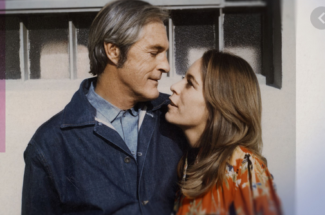My Psychedelic Love Story (Errol Morris, 2020): USA
Reviewed by Larry Gleeson. Viewed as the World Premiere Closing Night Film of the 2020 AFI FEST presented by Audi.
 The latest documentary, My Psychedelic Love Story, from the renowned documentary filmmaker of the Thin Blue Line and Fog of War (Academy Award winner), Errol Morris, comes a tell-all story of Johanna Harcourt-Smith, a once young, Swiis born, Paris-raised, jet-setting, aristocratic, Jewish woman who cavorted with the high priest of LSD, Timothy Leary. My Psychedelic Love Story is the story of Harcourt-Smith and O’Leary as they circumvent extradition and indulge themselves in daily acid trips for a two-month period before Leary is extradited back to the US, incarcerated, and eventually released. At the time there was much speculation Harcourt-Smith was a CIA plant – a Mata Hari of sorts.
The latest documentary, My Psychedelic Love Story, from the renowned documentary filmmaker of the Thin Blue Line and Fog of War (Academy Award winner), Errol Morris, comes a tell-all story of Johanna Harcourt-Smith, a once young, Swiis born, Paris-raised, jet-setting, aristocratic, Jewish woman who cavorted with the high priest of LSD, Timothy Leary. My Psychedelic Love Story is the story of Harcourt-Smith and O’Leary as they circumvent extradition and indulge themselves in daily acid trips for a two-month period before Leary is extradited back to the US, incarcerated, and eventually released. At the time there was much speculation Harcourt-Smith was a CIA plant – a Mata Hari of sorts.
Having recently watched The Trial of the Chicago 7, on Netflix, as My Psychedelic Love Story unfolded I cannot say I was surprised to see Timothy Leary jailed for such a long period of time over possession of a small amount of marijuana. The underlying story at play was the Nixon Administration making an example of another high-profile individual who encouraged others to think and act “outside the box.” All in the name of law and order – before Watergate became public and while the Vietnam War and student protests raged in the background.
Morris bases his work in My Psychedelic Love Story on a four-tape interview Leary gave with a prison psychologist. In agreeing to be interviewed, Leary makes clear in the tapes he wanted the love of his life, Ms. Johanna Harcourt-Smith, to have final custody of the tapes. But, according to Harcourt-Smith, her life centered on Leary and getting him his release from prison. Leary was undergoing hallucinogenic treatment while incarcerated. First from Harcourt smuggling in acid tabs in her belly button and through postage stamps on her letters sent through the US Postal Office and, subsequently, through prison therapy sessions.
Eventually, the government (the Federal Bureau of Investigation and the Drug Enforcement Agency) threatened Leary with an ultimatum – publicly announce his cooperation to halt the LSD crisis or spend the remainder of his life in a psychiatric ward with a fried brain. His incarceration would soon include his ingestion of stronger and stronger doses of hallucinogens until he lost his mind. Leary agreed to cooperate, was released from prison into the Witness Protection Program, and was living in a small cabin in Idaho with no electricity. One night he and Harcourt-Smith had an argument. Leary left in the middle of the night and Harcourt-Smith never saw Leary again.
Only within the last few years when some of her belongings were sent to her did Harcourt listen to the interview tapes from 1974. Morris has his Interrotron that allows for a powerful sense of intimacy as well as several other cameras placed at various angles and vantage points capturing Harcourt-Smith as she delivers a monologue of epic proportions. As Harcourt-Smith drifts from topic to topic Morris introduces still photographs, psychedelic art, archival footage, and even a clip from Alice in Wonderland.
Harcourt-Smith is a compelling storyteller. During her two-month jet setting romance with Leary, she recalls her conversations with Keith Richards and how she encouraged him to go to America and make albums with the Rolling Stones. And, the spur-of-the-moment trips to Switzerland, Afghanistan, France, and back again. Listening to her tell her tale coupled with Morris’ use of image inserts of colorful Tarot cards and hypnotic music, I felt captivated and often wondered how could Harcourt have such a vivid recollection of her and Leary’s travels on the run from the law. Nevertheless, My Psychedelic Love Story is quite a tale of what seems to have become a largely forgotten part of the turbulent 1970s. Highly recommended!
About this entry
You’re currently reading “My Psychedelic Love Story (Errol Morris, 2020): USA,” an entry on Student Film Reviews
- Published:
- 10.24.20 / 8pm
- Category:
- AFI Filmfest 2020, Documentary, Films
4 Comments
Jump to comment form | comments rss [?]